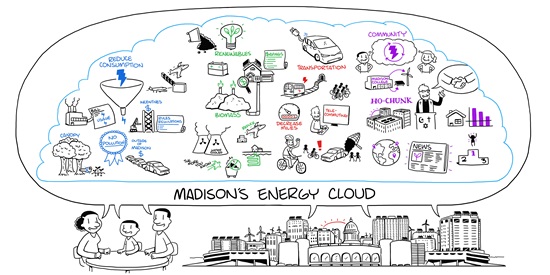- Climate Action
- Climate Action Plan
- Renewable Energy
- Renewable Energy
- Energy Cloud
- Local Clean Energy
- Conferences and Events
Cities Like Madison Lead the Way to Local Clean Energy

As the Inaugural North American Climate Summit convenes in Chicago, Illinois, cities from across North America are leading the way toward ambitious climate action. The shift to local clean energy, known as the Energy Cloud transition, is creating new space for cities to influence the energy ecosystem. This transition will accelerate even more quickly as the adoption of Energy Cloud platforms supporting smart cities, building-to-grid, electrification of transportation, and more increases.
Imagining the Energy Cloud at Madison
Cities such as Madison, Wisconsin are influencing the Energy Cloud transition through their push for renewable energy and the reduction of carbon emissions. In March 2017, the City of Madison became the 25 city in North America to set the ambitious goal of powering city operations with 100% renewable energy and zero net carbon emissions. Guidehouse, Inc. is working with the City of Madison to envision what the future Energy Cloud looks like in this community. At a public forum earlier this year, we created a depiction of an Energy Cloud based on public input about how the City of Madison could achieve zero net carbon emissions by working together with the community to implement energy efficiency, renewable energy, and efficient transportation.
Imagining the Energy Cloud at the City of Madison, Wisconsin

Source: Guidehouse (artist credit to Truscribe)
Madison’s “Energy Cloud” strategy includes making its facilities and operations more efficient, adding renewable energy generation, and identifying opportunities to incorporate renewable fuels and electrify its transportation fleet. People play an important role too. Influencing behavior by encouraging active transport, such as biking and walking, can help people reduce reliance on fossil transportation fuels and achieve health benefits through reduced air particulate matter and more active lifestyles. Additional ideas include training vehicle operators and building operators to operate vehicles and buildings as efficiently as possible.
Cities can’t accomplish their goals for renewable energy without working with utilities. The Energy Cloud includes opportunities for cities and utilities to work together. In Madison, the city is talking to two local utilities, Madison Gas and Electric (MGE) and Alliant Energy’s Wisconsin Power and Light (WPL), to identify areas of mutual interest. Topic areas include promoting energy efficiency, expanding solar and wind energy generation, expanding the use of EVs and developing charging infrastructure, and identifying opportunities to build social equity and economic development into these initiatives. The City of Madison and MGE have already made progress toward mutually identified goals: a recent grant will yield the first three all-electric Proterra Catalyst buses in Madison. Discussions with WPL are gaining momentum. The parties are looking at creative strategies such as building solar arrays on sloped industrial sites not well suited for buildings, possibly modeled after WPL’s successful West Dubuque Solar Garden project—the largest single solar array in the state of Iowa.
Leading the Way via People Power and Collaboration
Each city must envision its own Energy Cloud to account for the needs of its own stakeholders, including individual taxpayers, utilities, the business sector, environmental groups, and others. For Madison, people power and collaboration is key to moving closer to realizing 100% renewable energy. Cities like Madison are leading the way to implement an Energy Cloud transformation.
What does the Energy Cloud look like for your city? Guidehouse has identified five factors for success for cities that are looking to create their own Energy Cloud.